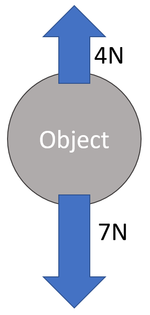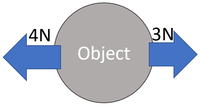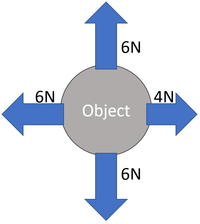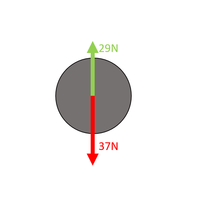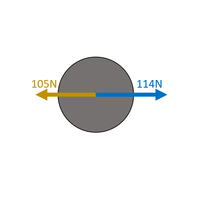Difference between revisions of "Unbalanced Forces"
| (7 intermediate revisions by 2 users not shown) | |||
| Line 11: | Line 11: | ||
|[[File:UnbalancedForces3.png|center|200px]] | |[[File:UnbalancedForces3.png|center|200px]] | ||
|- | |- | ||
| − | | style="height:20px; width:200px; text-align:center;" |The 4[[N]] up and the 7[[N]] down mean the [[object]] will [[accelerate]] downwards due to a [[Resultant Force|resultant force]] of 3[[N]]. | + | | style="height:20px; width:200px; text-align:center;" |The 4[[Newton|N]] up and the 7[[Newton|N]] down mean the [[object]] will [[accelerate]] downwards due to a [[Resultant Force|resultant force]] of 3[[Newton|N]]. |
| − | | style="height:20px; width:200px; text-align:center;" |The 4[[N]] left and the 3[[N]] right mean the [[object]] will [[accelerate]] to the left due to a [[Resultant Force|resultant force]] of 1[[N]]. | + | | style="height:20px; width:200px; text-align:center;" |The 4[[Newton|N]] left and the 3[[Newton|N]] right mean the [[object]] will [[accelerate]] to the left due to a [[Resultant Force|resultant force]] of 1[[Newton|N]]. |
| − | | style="height:20px; width:200px; text-align:center;" |The 6[[N]] up is '''balanced''' by the 6[[N]] down but the 6[[N]] left and the 4[[N]] right mean the object will [[accelerate]] to the left due to a [[Resultant Force|resultant force]] of 2[[N]]. | + | | style="height:20px; width:200px; text-align:center;" |The 6[[Newton|N]] up is '''balanced''' by the 6[[Newton|N]] down but the 6[[Newton|N]] left and the 4[[Newton|N]] right mean the object will [[accelerate]] to the left due to a [[Resultant Force|resultant force]] of 2[[Newton|N]]. |
|} | |} | ||
| + | |||
| + | ==Key Stage 4== | ||
| + | ===Meaning=== | ||
| + | '''Unbalanced forces''' are [[force]] [[vector]]s which add together to make a (non-zero) [[Resultant Force|resultant force]]. | ||
| + | |||
| + | ===About Balanced Forces=== | ||
| + | : When [[force]]s on an [[object]] are '''unbalanced''' it will [[accelerate]] (change speed or direction). | ||
| + | : '''Unbalanced forces''' are related to [[Newton's First Law]] of motion: | ||
| + | :: An [[object]] in motion will tend to stay in motion in a straight line and an [[object]] at [[rest]] will tend to stay at [[rest]] unless an [[Unbalanced Forces|unbalanced force]] acts upon it. | ||
| + | : If the [[Resultant Force|resultant force]] on an [[object]] is not zero, then the [[force]]s are '''unbalanced'''. | ||
| + | |||
| + | ===Examples=== | ||
| + | {| class="wikitable" | ||
| + | |- | ||
| + | |[[File:ResultantForce1.png|center|200px]] | ||
| + | |[[File:ResultantForce2.png|center|200px]] | ||
| + | |[[File:ResultantForce3.png|center|200px]] | ||
| + | |- | ||
| + | | style="height:20px; width:200px; text-align:center;" | | ||
| + | '''Choose which directions are positive.''' | ||
| + | |||
| + | Up is positive. | ||
| + | |||
| + | '''Calculate the [[Resultant Force]]''' | ||
| + | |||
| + | There is 29N up and 37N down. | ||
| + | |||
| + | F<sub>R</sub> = (+29N) + (-37N) | ||
| + | |||
| + | F<sub>R</sub> = -8N upwards | ||
| + | |||
| + | The [[force]]s are '''unbalanced'''. | ||
| + | | style="height:20px; width:200px; text-align:center;" | | ||
| + | '''Choose which directions are positive.''' | ||
| + | |||
| + | Right is positive. | ||
| + | |||
| + | '''Calculate the [[Resultant Force]]''' | ||
| + | |||
| + | There is 114N right and 105N left. | ||
| + | |||
| + | F<sub>R</sub> = (+114N) + (-105N) | ||
| + | |||
| + | F<sub>R</sub> = 9N right | ||
| + | |||
| + | The [[force]]s are '''unbalanced'''. | ||
| + | | style="height:20px; width:200px; text-align:center;" | | ||
| + | '''Choose which directions are positive.''' | ||
| + | |||
| + | Right is positive. | ||
| + | Up is positive. | ||
| + | |||
| + | '''Calculate the [[Resultant Force]]''' | ||
| + | |||
| + | There is 38N up and 38N down. | ||
| + | |||
| + | F<sub>R</sub> = (+38N) + (-38N) | ||
| + | |||
| + | F<sub>R</sub> = 0N upwards | ||
| + | |||
| + | The [[vertical]] [[force]]s are [[Balanced Forces|balanced]]. | ||
| + | |||
| + | '''Calculate the [[Resultant Force]]''' | ||
| + | |||
| + | There is 50N right and 40N left. | ||
| + | |||
| + | F<sub>R</sub> = (+50N) + (-40N) | ||
| + | |||
| + | F<sub>R</sub> = 10N right | ||
| + | |||
| + | The [[horizontal]] [[force]]s are '''unbalanced'''. | ||
| + | |||
| + | |} | ||
| + | |||
| + | ===References=== | ||
| + | ====AQA==== | ||
| + | |||
| + | :[https://www.amazon.co.uk/gp/product/019835939X/ref=as_li_tl?ie=UTF8&camp=1634&creative=6738&creativeASIN=019835939X&linkCode=as2&tag=nrjc-21&linkId=57e96876985fc39b1a3d8a3e3dc238b6 ''Unbalanced forces, pages 118-119, GCSE Physics; Third Edition, Oxford University Press, AQA ''] | ||
| + | :[https://www.amazon.co.uk/gp/product/0008158770/ref=as_li_tl?ie=UTF8&camp=1634&creative=6738&creativeASIN=0008158770&linkCode=as2&tag=nrjc-21&linkId=ec31595e720e1529e49876c3866fff6e ''Unbalanced forces, pages 146, 156, 180-1, GCSE Physics; Student Book, Collins, AQA ''] | ||
| + | |||
| + | ====Edexcel==== | ||
| + | |||
| + | :[https://www.amazon.co.uk/gp/product/1292120223/ref=as_li_tl?ie=UTF8&camp=1634&creative=6738&creativeASIN=1292120223&linkCode=as2&tag=nrjc-21&linkId=068ecf40278c32406a7f1c6e66751417 ''Unbalanced forces, page 13, GCSE Physics, Pearson Edexcel ''] | ||
Latest revision as of 16:02, 29 November 2019
Contents
Key Stage 3
Meaning
Unbalanced Forces are Forces acting in opposite directions with different magnitudes.
About Unbalanced Forces
- When there are unbalanced forces on an object the object will accelerate.
| The 4N up and the 7N down mean the object will accelerate downwards due to a resultant force of 3N. | The 4N left and the 3N right mean the object will accelerate to the left due to a resultant force of 1N. | The 6N up is balanced by the 6N down but the 6N left and the 4N right mean the object will accelerate to the left due to a resultant force of 2N. |
Key Stage 4
Meaning
Unbalanced forces are force vectors which add together to make a (non-zero) resultant force.
About Balanced Forces
- When forces on an object are unbalanced it will accelerate (change speed or direction).
- Unbalanced forces are related to Newton's First Law of motion:
- An object in motion will tend to stay in motion in a straight line and an object at rest will tend to stay at rest unless an unbalanced force acts upon it.
- If the resultant force on an object is not zero, then the forces are unbalanced.
Examples
|
Choose which directions are positive. Up is positive. Calculate the Resultant Force There is 29N up and 37N down. FR = (+29N) + (-37N) FR = -8N upwards The forces are unbalanced. |
Choose which directions are positive. Right is positive. Calculate the Resultant Force There is 114N right and 105N left. FR = (+114N) + (-105N) FR = 9N right The forces are unbalanced. |
Choose which directions are positive. Right is positive. Up is positive. Calculate the Resultant Force There is 38N up and 38N down. FR = (+38N) + (-38N) FR = 0N upwards The vertical forces are balanced. Calculate the Resultant Force There is 50N right and 40N left. FR = (+50N) + (-40N) FR = 10N right The horizontal forces are unbalanced. |
References
AQA
- Unbalanced forces, pages 118-119, GCSE Physics; Third Edition, Oxford University Press, AQA
- Unbalanced forces, pages 146, 156, 180-1, GCSE Physics; Student Book, Collins, AQA
